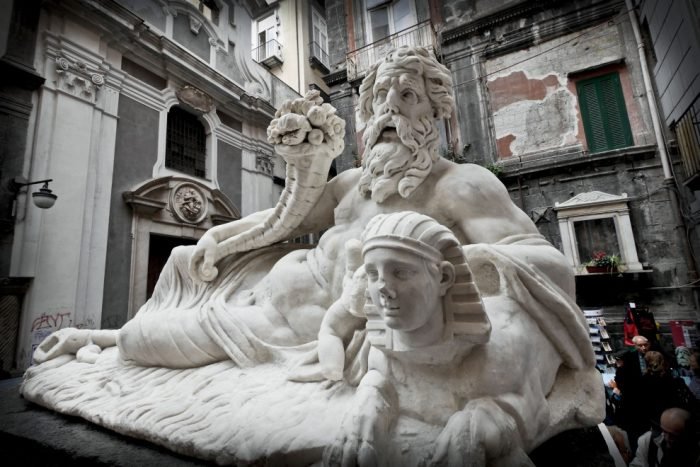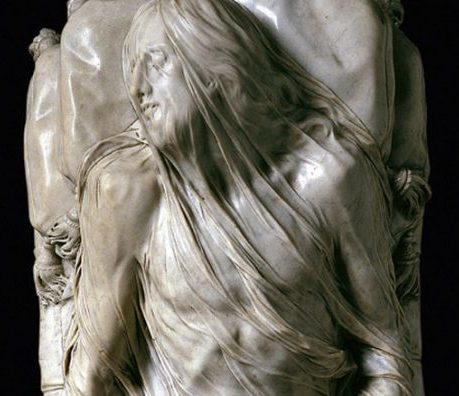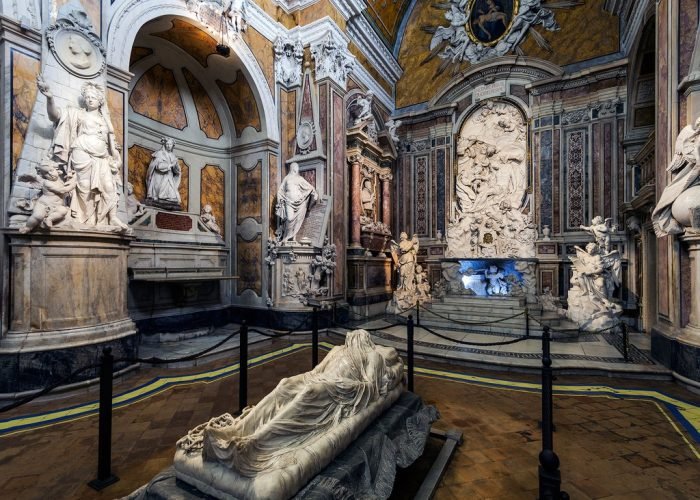MUST READ – Sinister Sites: The Sansevero Chapel
from Vigilant Citizen:
 Local legends about the Sansevero Chapel of Naples claim that the astonishing works of art it contains are the result of sorcery and black magic. The sculptures appear impossible to create by hand, while a macabre display featuring two actual human bodies is said to be the result of ritual killings. Also, adding to the occult aura surrounding the chapel, it is filled with Masonic symbolism.
Local legends about the Sansevero Chapel of Naples claim that the astonishing works of art it contains are the result of sorcery and black magic. The sculptures appear impossible to create by hand, while a macabre display featuring two actual human bodies is said to be the result of ritual killings. Also, adding to the occult aura surrounding the chapel, it is filled with Masonic symbolism.
At first glance, Capella Sansevero is your typical Italian chapel from the 17th century, tastefully filled with paintings and sculptures of a religious nature. However, a closer look at the various items in the chapel reveals that something is “off” about this place. Some sculptures are so “organic-looking” that they lead many to believe they were the result of a supernatural process. Furthermore, the enigmatic symbolism found around the chapel heavily hints to an allegorical esoteric message.
And, when visitors climb down a few stairs, they see this:

The chapel has on display two actual human remains with their entire nervous system on display. Creepily dubbed “Adam and Eve” – and even more creepily referred to as “anatomical machines” – this bizarre display has been the subject of all kinds of occult rumors.
To fully understand what is going on with the chapel, one must understand its creator: Raimondo di Sangro, the Prince of Sansevero. While he was considered a brilliant inventor and philosopher by many, others believed that he was a cruel black magician who killed people to conduct bizarre experiments.
A visit to his Sansevero Chapel gives credence to both points of view as it puts on display all of di Sangro’s alchemical genius … and madness. Before looking at the bizarre works of art on display at the chapel, let’s first look at the man behind it all.
Raimondo di Sangro, the “Sorcerer Prince”

From the age of 10, di Sangro was educated at the Jesuit College of Rome. In 1730, at age 20, he came back to Naples using the title “Prince of Sansevero”. He soon joined the ranks of occult secret societies.
“In spite of the religious training that he had received with the Jesuits, the young man soon joined the secret brotherhood of the Rosicrucians, where he was initiated into ancient alchemic rituals, the so called “sacred art” or “king’s art” which had been handed down through the centuries from Egyptian priest to their disciples. Don Raimondo had found his life calling. While maintaining the outmost silence about “his brothers” and the teachings he was receiving (he left no documents whatsoever on the activities of the mysterious sect) the Prince radically changed his life and devoted all his time to alchemy. Vials, ovens and alembics filled the cellar of his palace and at nighttime it was not rare to see strange, colored vapors and disgusting smells coming out of the barred windows of his cellar. It was at that time that Neapolitans started labeling him a sorcerer.”
– Rino Di Stefano, Raimondo de Sangro,
the “Sorcerer” Prince
Di Sangro introduced Freemasonry to his city as he became the head of the Neapolitan Masonic Lodge. This fact, combined with his knack for presenting peculiar inventions, such as an “eternal flame” made from a chemical compound of his creation and human skull bones, only grew the legend surrounding Di Sangro.
“Prince Raimondo di Sangro was known as an eccentric, enigmatic, and mystical man. He was the head of the Neapolitan Masonic lodge, the symbols of which are interspersed throughout the chapel, and was a student of numerous areas of the sciences, as well as alchemy and other mystical disciplines. He also spoke several exotic languages such as Hebrew and Arabic and was an inventor, some of his inventions of which were rather bizarre, such as a mechanized carriage with wooden horses that was said to be able to travel over both land and water. These eccentricities led to the Prince garnering a reputation as a practitioner of wizardry and black magic, and rumors abounded that he performed sinister magical rituals, human sacrifices, and curses. It was also said that he could perform great feats of alchemy, such as creating blood out of water or even thin air, and that he used the various body parts of his sacrificed victims in his odious spells and potions. The Prince was said to lock himself away for days on end and perform demented experiments on human beings, such as reanimating the dead. These dark rumors and legends that swirled around the Prince made him into a man to be feared and avoided; a larger than life black sorcerer who could bend magical and natural forces to his will. The Prince did little to deny these rumors and it is thought that he even encouraged them.”
– Brent Swancer, The Bizarre Anatomical Machines of Italy
One of di Sangro’s many “hobbies” was Bel Canto, which means “beautiful singing”. Sounds good, doesn’t it? Who doesn’t appreciate beautiful singing?
However, for di Sangro, “Bel Canto” means buying little boys from impoverished parents, castrating them and forcing them to sing.
“In spite of his being acquainted with the pleasures of family life and having children (…), the Prince enjoyed going around his many estates looking for young boys with beautiful voices. Usually he would find them in the church choir. Then he would “buy” them from their parents (usually poor, illiterate peasants who had many children) and had his personal physician, don Giuseppe Salerno, castrate them. He would then lock them up in the Conservatory of Jesus Christ’s Poor in Naples, where these young castrated boys started their careers as “sopranist”.
(…)
He saw in the castrati a search for perfection, which according to the Rosicrucians resulted from “annulling the dualism that comes from separation, a return to the primordial androgynous being”.
– Ibid.
As di Sangro’s reputation grew, and his writings gained publicity, he made powerful friends and powerful enemies. His involvement with Freemasonry lead to his writings being banned and for him to be ex-communicated by the Catholic Church.
He spent the later days of his life decorating the Sansevero Chapel, turning this small place into a grandiose representation of the “alchemical and Masonic path to illumination”.
A Mysterious Occult Temple
Before it was transformed by Raimondo di Sangro, the Sansevero Chapel was already the subject of bizarre rumors. It was said to have been constructed on an old temple of Isis and, to prove this fact, locals point to a massive Statue of the God of the Nile, located just around the corner from his home.

Adding to the sinister factor, the Palazzo Sansevero was the scene of a brutal murder at the end of the 16th century, when the composer Carlo Gesualdo caught his wife and her lover together and hacked them to death in their bed. Up until 1888, a passageway connected Palazzo Sansevero to the Sansevero chapel.
However, it is when Raimondo di Sangro turned this chapel into an alchemical project that the site became an attraction, especially in occult circles. Other than the enigmatic “hidden message” of the chapel, it is the works of art that mystify visitors. They appear to daringly declare: “I was an occultist and this is what I could do”.
The works of art in the Sansevero Chapel are indeed unique, powerful and unsettling, forcing visitors to ask: “How did he do that”? And, when one knows the esoteric and alchemical background of the Prince, observing them leads to the question: “Was this done through an occult process?”
The most compelling example of this is The Veiled Christ. Set in the middle of the chapel, this sculpture of Christ covered by a thin veiled has an unnerving quality: How was this marble sculpture made using a block of stone and a chisel? The veil is too … real.


“Completed in 1753 by Giuseppe Sanmartino and commissioned by Raimondo di Sangro, it portrays Christ deposed after crucifixion, covered by a transparent veil. This veil is rendered with such subtlety as to be almost deceiving to the eye, and the effect seen in person is really striking: one gets the impression that the “real” sculpture is lying underneath, and that the shroud could be easily grabbed and lifted.
It’s precisely because of Sanmartino’s extraordinary virtuosity in sculpting the veil that a legend surrounding this Christ dies hard – fooling from time to time even specialized magazines and otherwise irreproachable art websites.
Legend has it that prince Raimondo di Sangro, who commissioned the work, actually fabricated the veil himself, laying it down over Sanmartino’s sculpture and petrifying it with an alchemic method of his own invention; hence the phenomenal liquidness of the drapery, and the “transparence” of the tissue.”
– Bizarrobazar, The Mystery of Chapel Sansevero
For centuries, a “black legend” surrounded this sculpture and others in the chapel that held that the Prince used a mysterious alchemical process to “marbelize” a fine cloth placed over the sculpture.

Some observers noticed a troubling detail about that sculpture: Christ appears to still be breathing.




